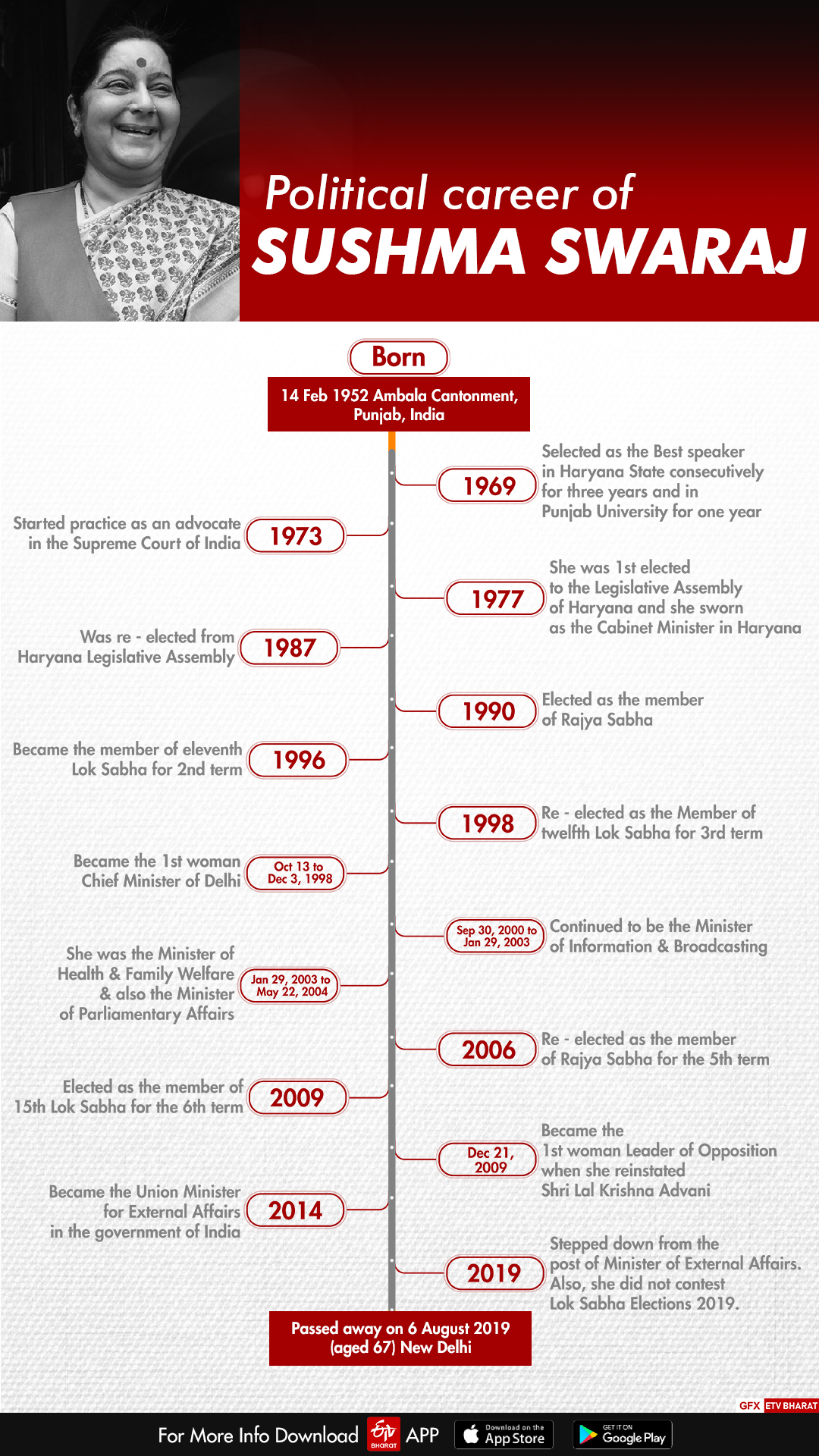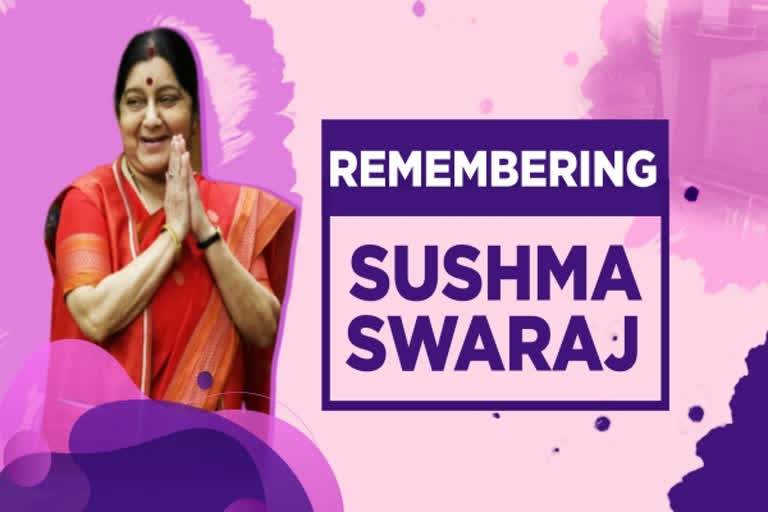Hyderabad: With the International Women's Day inching closer, it is important to reflect on the legacy of some of the most powerful women from India, and the list would be incomplete without mentioning former External Affairs Minister Sushma Swaraj, who was a politician of considerable consequence.
Swaraj, one of the most admired political leaders across party lines, bid adieu to the mortal world on August 7, 2019.
Although, Swaraj earned much appreciation during her political career spanning over decades, it was her stint as an External Affairs Minister, which was also the last portfolio held by her as a politician, that earned her an enviable reputation. She left behind a legacy of an easily-accessible external affairs ministry which helped the Indian diaspora in distress by her revolutionary social media outreach.
Here's a look at the life and times of Sushma Swaraj:
Early life
Sushma Swaraj was born on February 14, 1952, at the Ambala Cantonment in Ambala district of Haryana.
Her father, Hardev Sharma, was a senior and influential member of the Rashtriya Swayamsevak Sangh (RSS) - an Indian right-wing organisation.

She did her graduation in Sanskrit and Political Science from S. D. College in Ambala.
She further completed her LL.B. from Punjab University and began practising law in the Supreme Court in 1973.
Two years later, on July 13, 1975, she tied the knot with fellow lawyer Swaraj Kaushal whom she had a daughter named Bansuri with.
The duo was part of George Fernandes' legal team during Emergency.
Swaraj's foray into politics
Sushma Swaraj joined politics at a time when few women were part of India’s political scene, taking part in the anti-Emergency movement launched by Jayaprakash Narayan against the then prime minister Indira Gandhi.
She began her political career with Akhil Bhartiya Vidyarthi Parishad (ABVP) - student wing of the ruling Bharatiya Janata Party (BJP) - in the 1970s and later joined the Janata Party.
Slowly but surely her stature and importance in the party kept growing, and in 1977, she won the Haryana assembly elections by a landslide margin following which, at the age of 25, she was awarded the portfolio of a cabinet minister in the Janata Party government led by Devi Lal in Haryana, making her the youngest member of the Vidhan Sabha.
Swaraj became the Janata Party's State President in Haryana in 1979, a position she held for four years, and then joined the Bharatiya Janata Party (BJP) in 1984 where she was eventually appointed as the party secretary.
After this, she headed the Haryana education ministry from 1987 to 1990.
Her journey, however, from the state assembly to the Parliament was not an easy one.
She lost three consecutive Lok Sabha polls - 1980, 1984, and 1989 - to Congress' Chiranji Lal Sharma.
Finally, in 1990, she was nominated as a member to the Council of States (Rajya Sabha), and six years later she became a member of the second term of the 11th Lok sabha in 1996 after winning from the South Delhi seat.
She was made the minister of Information and Technology in Atal Bihari Vajpayee's Bharatiya Janata Party government which lasted 13 days. But during her short stint as the I&B minister, she took the historic decision to live telecast Lok Sabha proceedings.
Swaraj also went on to serve as the first female Chief Minister of Delhi from October 13- December 3, 1998. However, after being elected from Hauz Khas assembly seat of the national capital, she resigned from Delhi Assembly to retain her Lok Sabha seat.
While Swaraj enjoyed a good relation with rival political leaders, she could never see eye to eye with Congress chief Sonia Gandhi. It was her ardent opposition to Sonia Gandhi becoming the Prime Minister when the United Progressive Alliance gained power in 2004 that left everyone shocked. She had said, "if I go and sit in Parliament I shall always have to refer to Sonia Gandhi as honourable Prime minister, which is a prospect I do not look forward to. My national pride would not allow me to do that and I shall not be part of this exercise".
In 1999, she was chosen by the BJP to contest from Bellary in Karnataka against Sonia Gandhi, and she defeated her by a margin of 56,000 votes.
On December 21, 2009, she was chosen as the Leader of the Opposition replacing party veteran Lal Krishna Advani, becoming the first women to be appointed to the post. She held this position till 2014.
Then she went on to serve as the Minister of External Affairs in Prime Minister Narendra Modi-led cabinet from May 26, 2014, to May 29, 2019, thereby becoming the second woman to be appointed to the post after Indira Gandhi.
A career marked with many firsts
In 1977, at the age of 25, she became the youngest-ever cabinet minister.
She was appointed as the first female spokesperson of a national party.
Swaraj also served as the first female Chief Minister in the country.
She was the first female cabinet minister in a Union cabinet.
She was the first lady to be appointed as Leader of Opposition in the Lok Sabha.
In 2018, her Twitter follower count crossed the 11 million threshold, making Swaraj the world's most-followed woman leader, and of course the most followed foreign minister.
In 2019, she became the first Indian to address the Organisation of Islamic Cooperation (OIC) meeting as the guest of honour.
She was recognised as the best speaker by the Haryana state assembly.
She had also earned the distinction of being the first and the only woman to be awarded as the best parliamentarian in 2008 and 2010.



